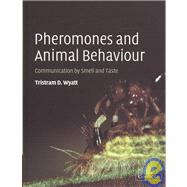
What is included with this book?
| Preface | xiii | ||||
| Acknowledgements | xiv | ||||
| 1 Animals in a chemical world | 1 | (22) | |||
|
1 | (1) | |||
|
1 | (5) | |||
|
6 | (3) | |||
|
9 | (3) | |||
|
12 | (4) | |||
|
16 | (1) | |||
|
17 | (1) | |||
|
18 | (2) | |||
|
20 | (2) | |||
|
22 | (1) | |||
|
22 | (1) | |||
|
22 | (1) | |||
| 2 Discovering pheromones | 23 | (14) | |||
|
23 | (2) | |||
|
25 | (1) | |||
|
25 | (4) | |||
|
29 | (2) | |||
|
31 | (3) | |||
|
34 | (1) | |||
|
35 | (1) | |||
|
36 | (1) | |||
|
36 | (1) | |||
| 3 Sex pheromones: finding and choosing mates | 37 | (37) | |||
|
37 | (1) | |||
|
38 | (2) | |||
|
40 | (1) | |||
|
41 | (2) | |||
|
43 | (3) | |||
|
46 | (11) | |||
|
57 | (2) | |||
|
59 | (1) | |||
|
60 | (1) | |||
|
61 | (3) | |||
|
64 | (8) | |||
|
72 | (1) | |||
|
73 | (1) | |||
| 4 Coming together and keeping apart: aggregation and host-marking pheromones | 74 | (13) | |||
|
74 | (1) | |||
|
74 | (9) | |||
|
83 | (2) | |||
|
85 | (1) | |||
|
86 | (1) | |||
| 5 Scent marking and territorial behaviour 87 | |||||
|
87 | (3) | |||
|
90 | (1) | |||
|
91 | (1) | |||
|
91 | (5) | |||
|
96 | (1) | |||
|
97 | (2) | |||
|
99 | (1) | |||
|
99 | (1) | |||
|
100 | (1) | |||
|
101 | (1) | |||
|
101 | (1) | |||
| 6 Pheromones and social organisation | 102 | (27) | |||
|
102 | (1) | |||
|
103 | (10) | |||
|
113 | (15) | |||
|
128 | (1) | |||
|
128 | (1) | |||
| 7 Pheromones and recruitment communication | 129 | (17) | |||
|
129 | (4) | |||
|
133 | (8) | |||
|
141 | (3) | |||
|
144 | (1) | |||
|
145 | (1) | |||
| 8 Fight or flight: alarm pheromones | 146 | (18) | |||
|
146 | (1) | |||
|
147 | (10) | |||
|
157 | (5) | |||
|
162 | (1) | |||
|
163 | (1) | |||
| 9 Perception and action of pheromones: from receptor molecules to brains and behaviour | 164 | (42) | |||
|
164 | (2) | |||
|
166 | (12) | |||
|
178 | (8) | |||
|
186 | (2) | |||
|
188 | (4) | |||
|
192 | (6) | |||
|
198 | (4) | |||
|
202 | (3) | |||
|
205 | (1) | |||
|
205 | (1) | |||
| 10 Finding the source: pheromones and orientation behaviour | 206 | (23) | |||
|
206 | (1) | |||
|
207 | (2) | |||
|
209 | (1) | |||
|
210 | (17) | |||
|
227 | (1) | |||
|
228 | (1) | |||
| 11 Breaking the code: illicit signallers and receivers of semiochemical signals | 229 | (22) | |||
|
229 | (1) | |||
|
230 | (7) | |||
|
237 | (3) | |||
|
240 | (1) | |||
|
241 | (3) | |||
|
244 | (5) | |||
|
249 | (1) | |||
|
249 | (2) | |||
| 12 Using pheromones: applications | 251 | (19) | |||
|
251 | (1) | |||
|
251 | (4) | |||
|
255 | (12) | |||
|
267 | (1) | |||
|
267 | (2) | |||
|
269 | (1) | |||
|
269 | (1) | |||
| 13 On the scent of human attraction: human pheromones? | 270 | (32) | |||
|
270 | (3) | |||
|
273 | (1) | |||
|
274 | (11) | |||
|
285 | (6) | |||
|
291 | (4) | |||
|
295 | (4) | |||
|
299 | (1) | |||
|
300 | (2) | |||
| Appendix A1 An introduction to pheromones for non-chemists | 302 | (2) | |||
| Appendix A2 Isomers and pheromones | 304 | (5) | |||
| Appendix A3 Further reading on pheromone chemical structure | 309 | (1) | |||
| References | 310 | (49) | |||
| List of credits | 359 | (12) | |||
| Index | 371 |
The New copy of this book will include any supplemental materials advertised. Please check the title of the book to determine if it should include any access cards, study guides, lab manuals, CDs, etc.
The Used, Rental and eBook copies of this book are not guaranteed to include any supplemental materials. Typically, only the book itself is included. This is true even if the title states it includes any access cards, study guides, lab manuals, CDs, etc.